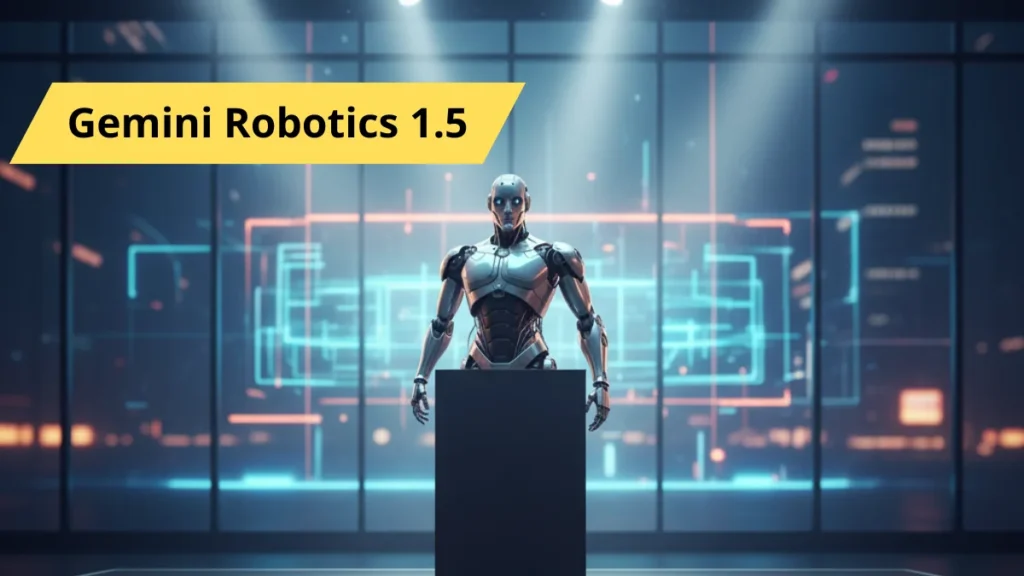Google is taking a major leap in robotics. The company has unveiled Gemini Robotics 1.5, a new AI system that allows robots to perceive, plan, and act in the real world.
By pairing advanced reasoning with motor control, Gemini’s latest models aim to solve one of robotics’ hardest challenges: completing complex, multi-step tasks with human-like intelligence.
Key Takeaways
- Gemini Robotics 1.5 blends vision, language, and action in real robots.
- New ER 1.5 model plans multi-step tasks with tool use and reasoning.
- Robots can now explain their actions in natural language for transparency.
- Cross-robot learning enables skills to transfer across different machines.
- Safety benchmarks upgraded with ASIMOV to align robots for real-world use.
Gemini Robotics 1.5 is Google’s latest AI system that combines vision, language, and motor control to let robots perceive, plan, and act in the physical world. Paired with Gemini Robotics-ER 1.5, the models enable multi-step reasoning, cross-robot learning, and safer, more transparent execution of complex tasks.
Gemini’s leap into embodied AI
Google has unveiled Gemini Robotics 1.5, a breakthrough step in artificial intelligence that moves beyond chatbots and into physical agents. The system integrates vision, language, and motor action to help robots tackle everyday tasks that once seemed out of reach.
The release, announced in September 2025, pairs Gemini Robotics 1.5 with a companion model, Gemini Robotics-ER 1.5, which acts as the “reasoning brain” behind robot decision-making.
How the two models work together
The two models function in tandem. Gemini Robotics-ER 1.5 handles high-level reasoning, spatial understanding, and planning — even pulling in external tools like Google Search when needed. It then issues step-by-step instructions in natural language.
Gemini Robotics 1.5 executes those steps, turning them into physical movement. Crucially, it can “think aloud,” explaining its reasoning in natural language before acting. This transparency could build trust in robots working alongside humans.
Why this matters for robotics
Most robots today struggle with tasks that require context and multiple steps. For example, sorting household waste involves identifying materials, checking local recycling rules, and placing items in the correct bins.
Gemini’s embodied AI makes this possible. By combining planning, vision, and physical action, the models demonstrate how robots could eventually take on household chores, warehouse logistics, or eldercare assistance with greater autonomy.
Learning across different robots
One standout feature is cross-embodiment learning. Robots built with different hardware — from humanoids like Apollo to dual-arm machines like Franka — can share skills without retraining each model from scratch.
Google reports that a task learned on one robot, such as laundry sorting, can be successfully performed by another, accelerating real-world deployment.
Safety and accountability
With AI systems moving into the physical world, safety is front and center. Google says Gemini Robotics 1.5 is built with semantic safety reasoning, meaning the system thinks about potential risks before acting.
The company also announced an upgraded ASIMOV benchmark, a dataset for testing robots against safety and alignment scenarios. Early results show Gemini Robotics-ER 1.5 outperforming rivals across 15 academic embodied reasoning benchmarks.
The bigger picture: AGI in the physical world
These advances aren’t just about smarter robots. They represent a step toward artificial general intelligence (AGI) that works beyond screens and keyboards. By reasoning, planning, and acting in the physical world, Gemini Robotics could reshape industries from manufacturing to healthcare.
Still, the rollout is gradual. As of launch, Gemini Robotics-ER 1.5 is available to developers via the Gemini API, while Robotics 1.5 is limited to select partners. Google emphasizes a staged approach, balancing innovation with safety.
Industry and research response
Early reactions in the robotics community suggest excitement but also caution. Researchers note that while cross-robot learning is a game-changer, robust safety testing will determine whether these systems can operate in homes, hospitals, and other human-centered spaces.
As one AI professor put it: “Transparency is key. The ability for a robot to explain its reasoning is not just impressive — it’s essential for human trust.”
What happens next
Developers can now access Gemini Robotics-ER 1.5 through Google AI Studio. Broader availability of Gemini Robotics 1.5 will depend on testing with trusted partners.
If successful, this could be the first generation of robots that move beyond scripted automation — capable of learning, reasoning, and adapting in dynamic environments.
Conclusion
Google’s Gemini Robotics 1.5 marks a turning point in AI: the fusion of digital reasoning with physical action. If safety, trust, and usability hold up, it could bring AI out of the cloud and into our daily lives.
